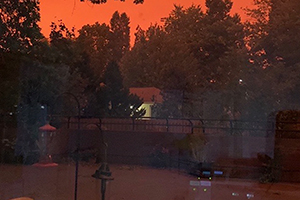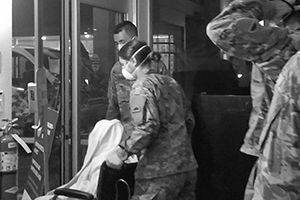By JULIE MINDA
Sept. 18, 2020

The view from a window at Providence Benedictine Nursing Center skilled nursing and assisted living campus in Mount Angel, Oregon, shows the orange sky from the wildfires in early September. The fire threat prompted the evacuation of residents from the center. All of them had returned as of Sept. 18.
Catholic health facilities in regions of the western United States that are being ravaged by wildfires are in disaster response mode.
More than 6 million acres of land have burned across 10 states since the start of this year, with 4.6 million of those acres still burning as of mid-September, according to information from AccuWeather. The fires have killed at least 35 people, spurred rolling blackouts, and caused billions of dollars in damages, the Associated Press reports.
PeaceHealth, Providence St. Joseph Health and CommonSpirit Health all have facilities in California and/or Oregon responding to wildfire impacts. Several clinics were closed temporarily and patients offered virtual appointments because of fire threat, thick smoke or staffing shortages resulting from emergency evacuations of residential areas. But overall, the systems have maintained services under extraordinary conditions, ensured the safety and protection of patients and staff, sustained staffing levels despite the disruption of residential evacuations, kept supplies stocked and reached out to community members in need.
Leaders of the systems and their facilities say they expect to be addressing medical, mental health and socioeconomic impacts of the fires well into the future. "This year's wildfire season is wreaking havoc in many Providence communities across the Western U.S," Dr. Rod Hochman, Providence St. Joseph Health president and chief executive, wrote in a Sept. 14 blog post. "The destruction is heart-wrenching. Yet the dedication of our caregivers remains steadfast."

Oregon Army National Guard troops help move patients from Providence Willamette Falls Medical Center in Oregon City in early September. The hospital used early discharge and transfers to reduce its patient count from 73 to eight in less than 24 hours as wildfires threatened.
Oregon blazes
Among the most impacted Providence Oregon sites were Providence Medford Medical Center in Medford, in Southern Oregon near the California border; the Providence Benedictine Nursing Center skilled nursing and assisted living campus in Mount Angel and Providence Willamette Falls Medical Center in Oregon City and clinics in surrounding communities. Mount Angel and Oregon City are in Northwest Oregon.
The threat of encroaching fires in early September spurred the Benedictine nursing home to evacuate most of its 110 patients and residents. Eighty of them transferred to other Providence facilities, others chose to stay with loved ones. Twenty-one residents stayed at the facility.
Emily Dazey, the facility's executive director, praises the dedication of many staff who accompanied very fragile patients and stayed with them at their new care sites. The nursing home sustained no damage, and all the residents were back by Sept. 18, Providence spokesman Gary B. Walker said.
And as wildfires blazed in Oregon City in early September, Providence Willamette Falls hospital responded to a "get set" evacuation notice, using early discharge and patient transfers to reduce its patient count from 73 to eight in less than 24 hours. Staff accompanied patients who had been transferred, in order to maintain consistent care. Hospital Chief Executive Russ Reinhard says many caregivers stepped up to help one another undertake the feat.
In Southern Oregon, Providence's Medford hospital remained open and took in more than 20 people evacuated from other hospitals, skilled nursing facilities, foster programs and hospice programs. At one point, the hospital and its emergency department neared its capacity as many older evacuees sought care. Most hospital staff worked through the night to manage emerging needs.
Lisa Vance, executive vice president and chief executive of Providence Health & Services Oregon Region, grew up in Medford and her mother and sister still live there. In an emotional video posted Sept. 9, she thanked all Providence care givers in Oregon, calling them heroes.
California flames
When California wine country experienced its worst fire season ever in mid- to late August, Providence St. Joseph's Santa Rosa Memorial Hospital in Santa Rosa, Petaluma Valley Hospital in Petaluma and Queen of the Valley Medical Center in Napa drew on knowledge gained over the past three years of brutal fire seasons, says Dr. Amy Herold, Queen of the Valley chief medical officer. The hospitals were quick to link their incident command centers and turn on air-scrubbing machines. Herold says additional scrubbers were brought in from other Providence hospitals.
Providence colleagues in information technology, human resources and other departments worked around the clock to help redeploy nurses from other Providence sites to shore up the staff counts at the northern California facilities, Herold says, Hospitalists and other physicians volunteered to fill in gaps in staffing as well.
Herold says the hard work of the staff made it possible for Queen of the Valley to accept incoming patients when Adventist Health St. Helena was forced to evacuate in August.
Incident command
In PeaceHealth's Oregon network, the sites most affected by mid-September fires were in west central Oregon and included PeaceHealth Sacred Heart Medical Center at RiverBend in Springfield; PeaceHealth Sacred Heart Medical Center University District in Eugene, Oregon; and the critical access hospital, PeaceHealth Cottage Grove Community Medical Center in Cottage Grove.
Elva Sipin, PeaceHealth Sacred Heart's vice president of operations, leads the systems incident command center structure for the wildfire response. None of the three hospitals were damaged. Sipin says the incident command center set up for the facilities keeps in touch with local fire chiefs for updates on the possibility of evacuation (so far, unneeded). They've been using scrubbing equipment to maintain indoor air quality and staying abreast of staffing needs as employees are forced to evacuate their homes and find shelter elsewhere.
Sipin says she and other leaders have been humbled by the selflessness of employees in ensuring quality medical care is delivered during the wildfire disaster.
Joann Wardrip, manager of media relations and social media for CommonSpirit Health, said two of that system's hospitals -- Sierra Nevada Memorial Hospital in Grass Valley and Dignity Health Dominican Hospital in Santa Cruz – had faced potential evacuation because of the California wildfires.
"Thankfully, we didn't have to enact our contingency plans and continued to treat our patients," she said Sept. 17. "We also had a few clinics that closed, one of which was temporarily relocated, but they have since reopened and are serving our patients."
Emerging need
PeaceHealth and Providence executives say that during the worst of the fires and in their immediate aftermath, their facilities' emergency departments did see an uptick in volume, with burn victims and people with broken bones and respiratory issues being admitted. Since people have begun trickling back into communities as the fire danger waned, emergency departments have been treating community members who went without medications during evacuations or whose chronic conditions have been aggravated by the smoky conditions.
PeaceHealth and Providence have been reaching out to their communities. For instance, PeaceHealth has been pushing out messages on how to protect oneself from respiratory conditions caused by dense and sometimes toxic smoke. Providence Medford clinicians have been traveling to evacuation sites to tend to people's medical needs. And Providence northern California community outreach teams have been trying to locate patients in the community to ensure their medical needs are met.
Additionally, both PeaceHealth and Providence are helping people find mental health resources for handling the trauma they're experiencing.
Elizabeth McCabe, chief mission integration officer of Providence Oregon, says "when wildfires ravage areas where Catholic health care is present, our own caregivers and facilities become vulnerable. Everyone is impacted, some more significantly than others, but we all stand in solidarity as we care for patients and each other.
"By giving and receiving tender compassion and love we gain a renewed sense of hope that strengthens our collective ability to respond to such devastating and overwhelming needs," she says.
Lisa Eisenhauer contributed to this report.